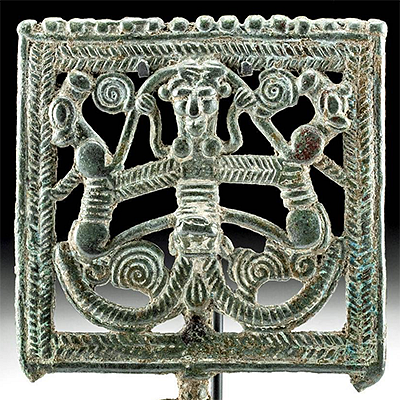Medieval Tin / Lead Pilgrim Badge - Horse & Rider
Lot 32a
About Seller
Artemis Gallery
686 S Taylor Ave, Ste 106
Louisville, CO 80027
United States
Selling antiquities, ancient and ethnographic art online since 1993, Artemis Gallery specializes in Classical Antiquities (Egyptian, Greek, Roman, Near Eastern), Asian, Pre-Columbian, African / Tribal / Oceanographic art. Our extensive inventory includes pottery, stone, metal, wood, glass and textil...Read more
Categories
Estimate:
$1,000 - $1,500
Absentee vs Live bid
Two ways to bid:
- Leave a max absentee bid and the platform will bid on your behalf up to your maximum bid during the live auction.
- Bid live during the auction and your bids will be submitted real-time to the auctioneer.
Bid Increments
| Price | Bid Increment |
|---|---|
| $0 | $25 |
| $300 | $50 |
| $1,000 | $100 |
| $2,000 | $250 |
| $5,000 | $500 |
| $10,000 | $1,000 |
| $20,000 | $2,500 |
| $50,000 | $5,000 |
| $100,000 | $10,000 |
| $200,000 | $20,000 |
About Auction
By Artemis Gallery
Nov 5, 2020
Set Reminder
2020-11-05 10:00:00
2020-11-05 10:00:00
America/New_York
Bidsquare
Bidsquare : Ancient & Ethnographic From Around the World
https://www.bidsquare.com/auctions/artemis-gallery/ancient-ethnographic-from-around-the-world-5916
Ancient art from Egypt, Greece, Italy and the Near East, as well as Asian, Pre-Columbian, Native American, African / Tribal / Oceanic, Spanish Colonial, Russian Icons, Fine art, much more! All categories, all price ranges... all legally acquired and guaranteed to be as described or your money back. Artemis Gallery info@artemisgallery.com
Ancient art from Egypt, Greece, Italy and the Near East, as well as Asian, Pre-Columbian, Native American, African / Tribal / Oceanic, Spanish Colonial, Russian Icons, Fine art, much more! All categories, all price ranges... all legally acquired and guaranteed to be as described or your money back. Artemis Gallery info@artemisgallery.com
- Lot Description
Europe, Medieval Period, ca. 1350 to 1450 CE. A fragment of a pilgrim tin-lead alloy badge depicting a horse and rider - the steed adorned by granulated circular motifs on its body and bridle and well as presenting with a wavy mane and tail - the rider's body donning a cloak with delineated flowing drapery - the reins also visible. Just who did this badge depict? Perhaps St. George slaying the dragon or St. Martin of Tours - regardless, though a fragment, what remains is exquisitely rendered. Size: 3" L x 1.875" H (7.6 cm x 4.8 cm)
People of the Middle Ages went on pilgrimages to the tomb of a saint, or a site where relics of a saint(s) were venerated. The pilgrim might pray at a shrine in order to thank the saint for miraculous healing or cure. However, for some the journey itself was a means of purification. In addition to voluntary pilgrimages, some pilgrimages were a form of punishment imposed by the courts or the Church. A person might have been ordered to make a pilgrimage to Rome for example, remain there for several years, and bring back some evidence like a pilgrim badge. Besides wearing a voluminous cloak (the pelerine) and a large hat with a wide brim, carrying a wooden pilgrim’s staff, a scrip (a pilgrim's flask) and a rosary, the most important signs of a pilgrim were the petite pewter pilgrims' badges he pinned to his hat, scrip, or cloak. At every pilgrimage site, a pilgrim could acquire a pilgrims' badge sold as a consecrated souvenir of the sacred place, just as they can do this today.
Provenance: ex Estate of Eldert Bontekoe, Pegasi Numismatics, Ann Arbor, Michigan USA acquired before 2000
All items legal to buy/sell under U.S. Statute covering cultural patrimony Code 2600, CHAPTER 14, and are guaranteed to be as described or your money back.
A Certificate of Authenticity will accompany all winning bids.
We ship worldwide and handle all shipping in-house for your convenience.
#160496Fragment of a larger piece; missing horse's legs, head, and tail and rider's head, shoulders, arms, and feet as shown. Rich patina with excellent remaining detail.Condition
- Shipping Info
-
All shipping is handled in-house for your convenience. Your invoice from Artemis Gallery will include shipping calculation instructions. If in doubt, please inquire BEFORE bidding for estimated shipping costs for individual items.
-
- Buyer's Premium



 EUR
EUR CAD
CAD AUD
AUD GBP
GBP MXN
MXN HKD
HKD CNY
CNY MYR
MYR SEK
SEK SGD
SGD CHF
CHF THB
THB













